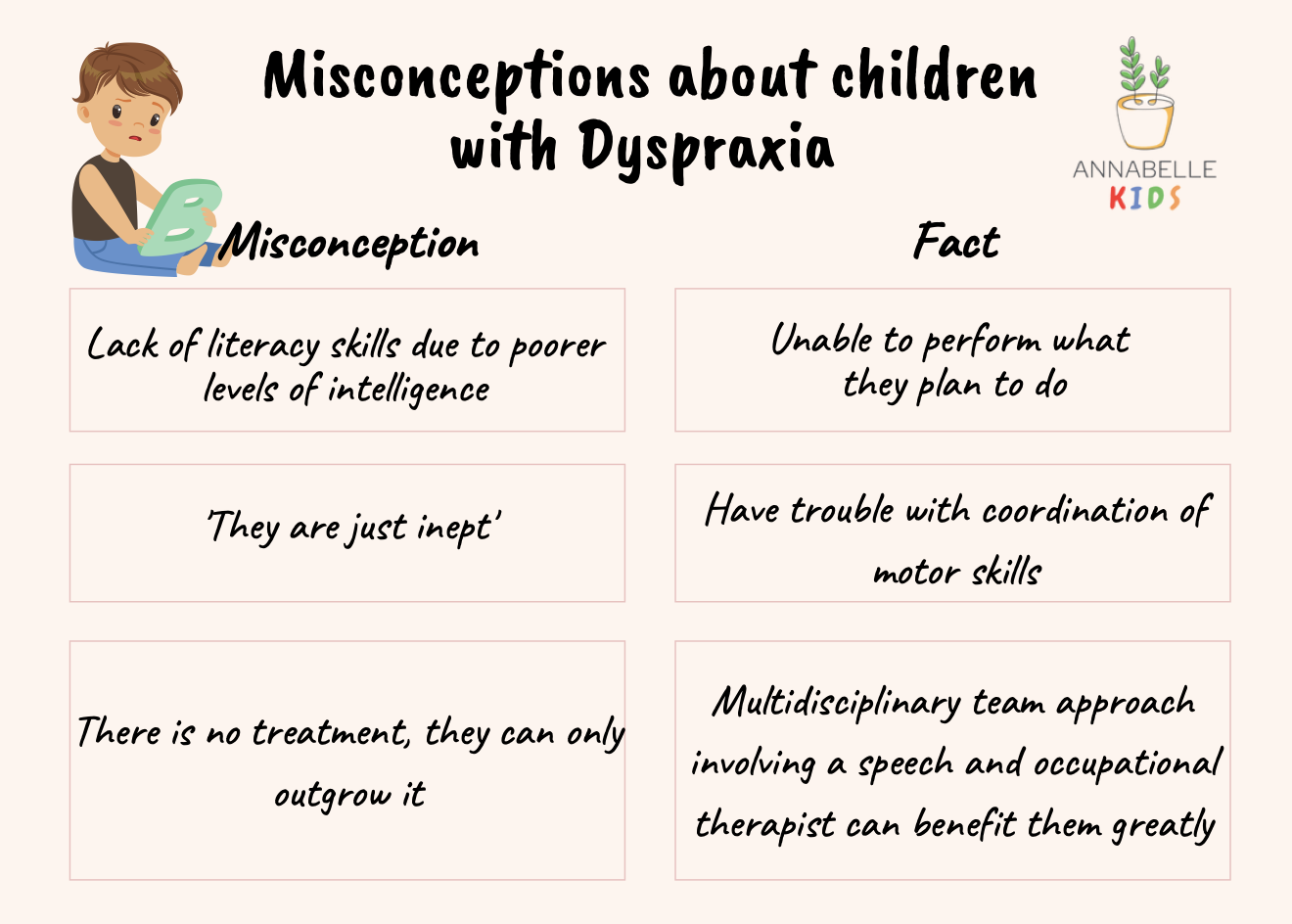Developmental Coordination Disorder (DCD)
more commonly known as Dyspraxia
Every child is unique. Just like how children utter their first words or take their first steps at different ages, each child’s developmental progression varies at their own pace. For example, Julie is a beautiful four-year-old who can speak in full sentences of more than five words. She can name a few different colours and is able to answer simple questions like ‘Do you prefer a sunny or rainy day?’. On the other hand, although Timothy also shares the same chronological age as Julie, he has difficulty completing a full sentence and struggles to hold a pencil properly between his fingers and thumbs.
Typically, children (like Timothy) with temporary developmental delays are not a cause for concern as most gradually grow out of their symptoms. However, what if this delay continues to persist? What if a child still struggles to balance, and has troubles with speech even at the age of four? Developmental delays can be caused by a wide range of factors, sometimes it indicates an underlying condition many are unaware of. One such condition is the Developmental Coordination Disorder (DCD), also reputably recognised as Dyspraxia.
Dyspraxia is often referred to as the “hidden handicap” of all disorders. It has earned this title as it is a condition commonly overlooked due to its overlapping symptoms with a variety of other disorders such as Attention Deficit Hyperactivity Disorder (ADHD) and Autistic Spectrum Disorders (ASD). As a result, a diagnosis of Dyspraxia is frequently overlooked until the child is five years or older. In the pediatric population, the prevalence rate of children diagnosed with Dyspraxia currently stands at 5-6%, affecting boys four times more frequently than girls.
What is Dyspraxia?
Dyspraxia is a condition in which a child’s coordination of motor skills falls well short of what is expected for his or her chronological age. It is a neurological disorder that causes messages from the brain to be incorrectly interpreted by the body due to underdeveloped portions of the brain.
Without intervention, a child may face difficulty in speech, movement, or coordination. They also frequently lack literacy skills such as reading and writing, which can cause academic difficulties, such as poor academic performance and be slow to pick up new skills. This deficit stems from their inability to execute what they plan to do which gives rise to recurrent feelings of frustration and anger - imagine how frustrating it is to be unable to speak what’s on your mind all the time!
Accordingly, children diagnosed with Dyspraxia experience:
Higher levels of emotional distress including:
Anxiety
Depression
Low self-esteem, and are
Less likely to engage in group activities with peers
There are three types of dyspraxia in children – motor, oral and verbal dyspraxia.
Despite the high rates of Dyspraxia, people unfortunately still often hold several misconceptions about children with Dyspraxia. Here they are, debunked
How is Dyspraxia diagnosed?
Dyspraxia is only diagnosed when a child’s motor skills deficit negatively interferes with their performance of daily activities at home, school, or social life. According to the Diagnostic and Statistical Manual of Mental Disorders (DSM-5), here are the various characteristics of children with Dyspraxia:
1. Given the child’s chronological age, the development and performance of coordinated motor skills are significantly lower than expected.
E.g., Struggling with messy handwriting, poor hand-eye coordination skills, and troubles with speech and language concepts even at the age of four, etc.
2. The child’s motor skills deficit significantly and negatively impacts daily living activities.
E.g., Difficulty communicating with peers in school due to speech difficulties, problems with dressing up and preparing meals at home, etc.
3. Symptoms first appear during the early stages of development.
E.g., High levels of motor activity such as feet swinging when seated, high levels of excitability, poor sense of balance at the age of three to five, etc.
4. The child’s motor skills deficit is not better explained by intellectual disability, or attributable to a neurological condition affecting movement.
A multidisciplinary team comprising of a child psychologist, speech and language therapist, and occupational therapist is optimal for a diagnosis of Dyspraxia in children. Having a group of child therapists in a multidisciplinary team provides a comprehensive assessment above and beyond an assessment from a single touchpoint as it takes into account a child’s development from different key domains. Following the assessment, the multidisciplinary team can follow up with a more detailed and full-range plan to address it. The multidisciplinary team will use appropriate assessment tools to evaluate the strengths and needs of the child. Once Dyspraxia has been diagnosed, an individualized management plan can be implemented to address the child’s specific needs.
Can Dyspraxia be managed?
This depends on its severity. A small proportion of children with mild symptoms, such as clumsiness or illegible handwriting, may eventually grow out of their symptoms. Unfortunately, the vast majority of children require long-term assistance and are affected throughout adolescence and adulthood.
Here at Annabelle Kids (AKIDS), our child psychologists and therapists use evidence-based therapies such as Cognitive Behavioural Therapy (CBT), Multidisciplinary Therapy involving Occupational and Speech Therapies, and Play Therapy, which can help children manage their difficulties. While there is no doubt that Dyspraxia is challenging for both child and parent to cope with – both emotionally, psychologically, and physically – that doesn’t mean that the future is bleak. Early intervention is key.
Cognitive Behavioural Therapy (CBT)
As mentioned, children diagnosed with Dyspraxia tend to experience higher levels of emotional distress. To help a child better cope, a child psychologist may use the CBT approach to identify children’s distortions, change unhelpful thinking and behavioural patterns.
For example, children with Dyspraxia commonly have anxious thoughts about things that might happen such as being laughed at by the class if they are unable to perform the same skills as their peers. Hence, a child psychologist teaches the child better ways to cope with these anxious thoughts by restructuring them with positive ones instead. In this case, a child psychologist will break down why a child with Dyspraxia may feel anxious to be laughed at by the class, and work with them to find solutions to their current difficulties.
Multidisciplinary Therapy: Occupational and Speech Therapy
As children with Dyspraxia struggle with coordination and fine motor skills, Occupational Therapy is an essential intervention component. An occupational therapist utilizes a range of strategies to build on the child’s weakness of motor skills. Depending on what the child’s weakness is, Occupational Therapy includes practicing activities of daily living (ADLs) such as handwriting, tying shoelaces, feeding themselves, etc. The goal of Occupational Therapy is to equip the child with the necessary skills to maximise their independence.
In addition, children diagnosed with Dyspraxia tend to struggle with speech and language concepts. Hence, Speech Therapy can help children with this speech disorder by facilitating the child to speak in an accepted and non-judgmental environment. Speech and language therapists will carry out assessments and identify the child’s presenting difficulties before having a targeted intervention programme to improve on the child’s speaking difficulties.
Play Therapy
Play Therapy utilizes play activities and materials to allow the child to play out their feelings, and understand relationships in actions instead of words. At AKIDS, our child therapists adopt a play therapy approach by creating a learning environment where the child feels comfortable and accepted as the child communicates their feelings through the action of playing. It involves the use of playing with items to keep the child engaged during therapy. Play therapy aims to develop a child’s soft skills and confidence levels to communicate better with their peers.
How can I support my child with Dyspraxia?
Caring for a child with Dyspraxia can be mentally stressful and emotionally draining at times. As a parent, it is natural to want to give your presence, love, and support to your child as much as possible. However, parents should first care for themselves before they can provide their children with the necessary care and support needed – parents’ emotional well-being is just as important as their child’s!
It is typical to see parents overcome feelings of guilt, anger, or even helplessness. Even more confusing are the conflicting emotions of love and hope on one day, and the next filled with resentment, shame, and grief. By sheer will and perhaps parental instinct, parents set these feelings aside because they have the misbelief that having such helpless thoughts and feelings does not add value to the situation. However, chronic stress can lead to depression, anxiety, substance use, etc., unknowingly opening a whole other can of worms over time.
The psychological well-being of parents or caregivers of children is not openly discussed enough. Here are some tips to cope with some emotional challenges from caregiving a child suffering from mental health disorders:
Ψ Acceptance and Commitment Therapy (ACT)
ACT acts as an intervention to protect supporting parents’ mental health by managing their stress and difficulties from caring for a child with mental health issues. It encourages parents to embrace their thoughts and feelings instead of putting these feelings aside. ACT allows you to accept your circumstance and your feelings towards it, even if it is negative. For example, ACT helps parents to refrain from blaming themselves or having any feelings of guilt or anger about their child’s diagnosis of Dyspraxia.
Ψ Mindfulness
Mindfulness-Based Therapy can help support caregivers to manage their chronic stress from caring for a child with Dyspraxia. Practicing mindfulness not only enhances caregivers’ emotional well-being, but also helps to develop qualities such as acceptance and compassion, preventing us from burning out.
Apart from the list of interventions, there are some ways parents can support their children with dyspraxia at home. It is crucial to include family into intervention programmes as the family is the most direct circle of influence surrounding the child. Here are two ways you can help your child’s progress with Dyspraxia:
Ψ Frequent speech and occupational practice at home
Accelerate your child’s progress by arranging a time each day to work on your child’s speech and occupational skills. Recap some exercises that were done with the speech and occupational therapist, and practice it at home when available.
Ψ Encouragement, Encouragement, Encouragement!
As children with Dyspraxia tend to have low self-esteem, they may be unwilling to engage in leisure activities or group activities with peers. Encourage your child to develop hobbies or interests of their own through support. Your support may come from celebrating the achievements in their hobby. For example, buying their favourite food after they have finished reading a book, or giving words of affirmation such as ‘I am proud of you’ after scoring a goal. The intention behind encouraging them is to motivate them to keep going.


